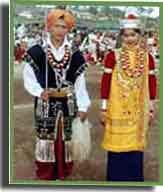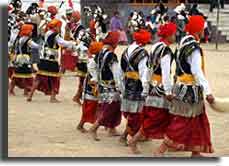History
Khasi were earliest immigrant tribes who came from Myanmar and settled down in the plains of east Assam. Later they had their own kingdom, until the British exercised control over them. The word Khasi is derived from Shankradeva's 'Baghavata Purana', an Indo Aryan literature.
Orgin
Khasi tribes reside in different parts of India like state of Assam, the Khasi Jaintia hills in Meghalaya, in Punjab, Uttar Pradesh, Manipur, West Bengal and Jammu & Kashmir. They are called by the different names such as Khasi Pahris, Khuchia, Kassi, Khashi and Khasa. A large part of Khasi population is found in the state of Meghalaya.
Culture
TThe main difference of Khasis which sets Apart from other tribes is that in Khasis the descendents are recognised from Mother and not from Father (Matrilineal Society). This is the unique feature of Khasi Tribe. According to Khasi Law and tradition the mother inherits the children and property but not the father. According to Khasi Laws the Marriage is purely a Civil Contract. Male's marraigeable age group is from 18-35 while women's is 13-18. Arrangd marriages do occur but not in a preferred form. Young men and women are given freedom to choose their mates. According to Law, a woman cannot be forced into marriage; she owns the children and properties. A woman may end the marriage at her will with no objection from her husband. The youngest daughter is the custodian of the family property.

Place /Location (then and now) |
Meghalaya, in Punjab, Uttar Pradesh, Manipur, West Bengal and Jammu & Kashmir, Arunachal Pradesh, Assam |
Population |
879,000. Almost fifty percent of the population of Meghalaya |
Languages spoken |
Khasi is the language spoke by Khasis |
Religion/God |
Khasi pantheon is the God simply referred to as U Blei ("the God"). |
Food |
Rice & Beer |
Occupation
Khasis cccupation is called as JHUM Means shifting cultivation for their survival. They have a peasant based economy.
People
Khasis have brown to light yellow skin and have folds on their skin with aquiline noses. They also love wearing jewellery. They wear silver or gold crown on their head. Khasi men wear large earrings. Women wear different earrings which are circular or oval shaped. Both men & women wear gold and silver chains around their waists.
Staple Food
Staple food of the Khasis is Rice. Apart from rice they take fish and meat. On the ceremonial occasions they love drinking Rice beer.
Languages
Khasi is the language spoke by Khasis, which is an Austro- Asiatic language. It is the part of the Mon-Khmer group of languages.
Festivals

It is popularly known as the Ka Pomblang Nongkrem.
Another major festival celebrated among the Khasis is known as the Shad Suk Mynsiem.
It lasts for three days celebrated in the month of April.


